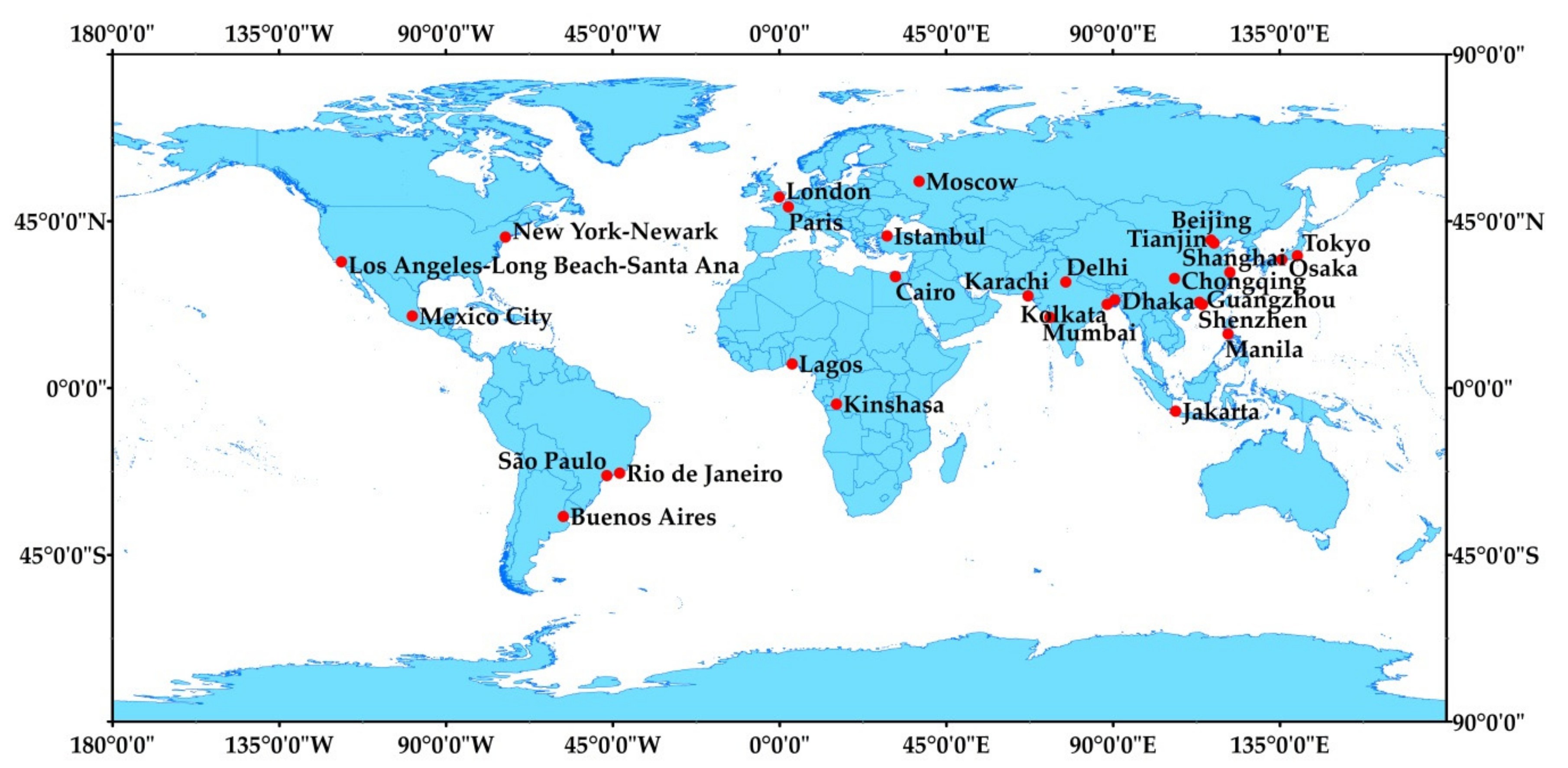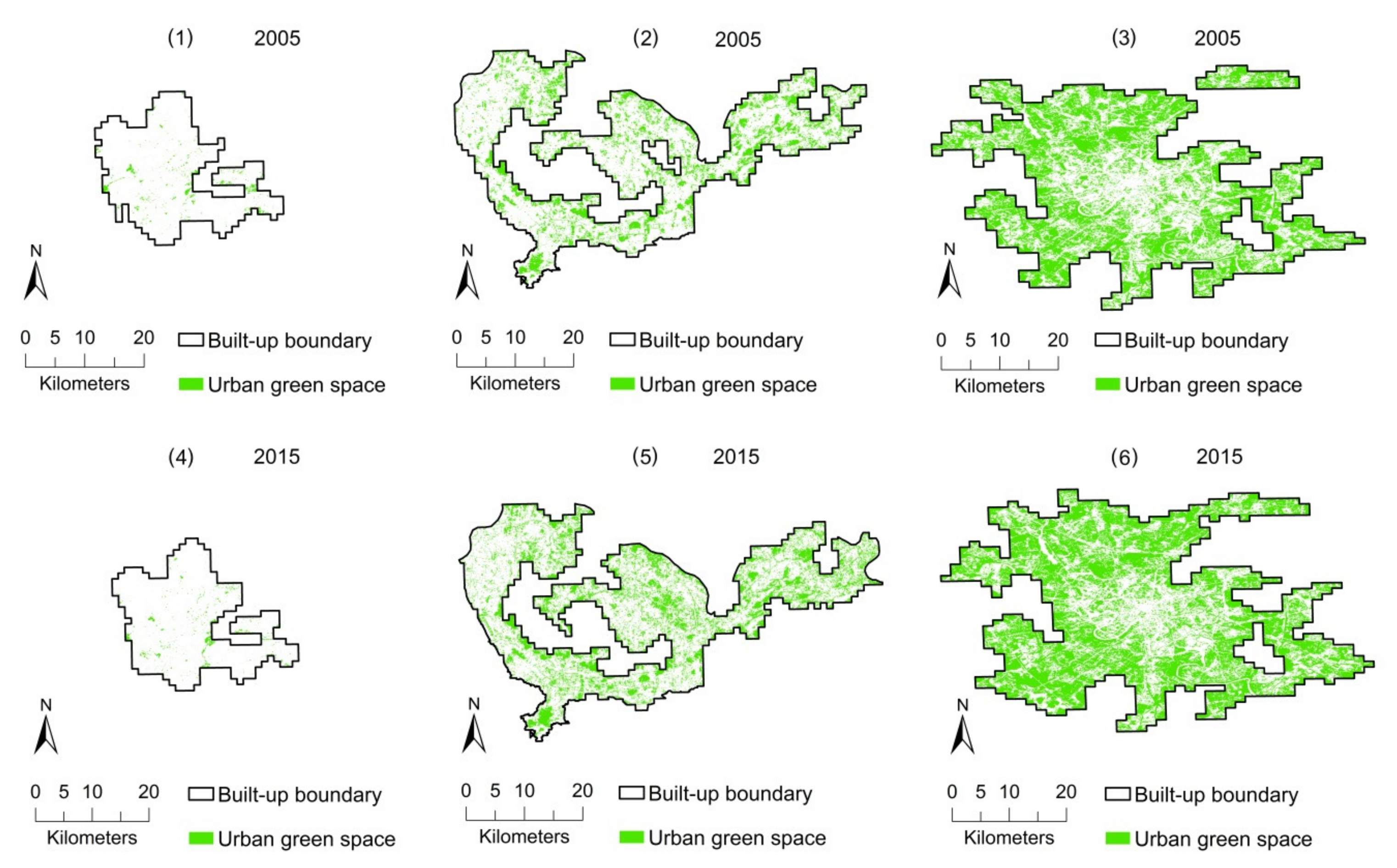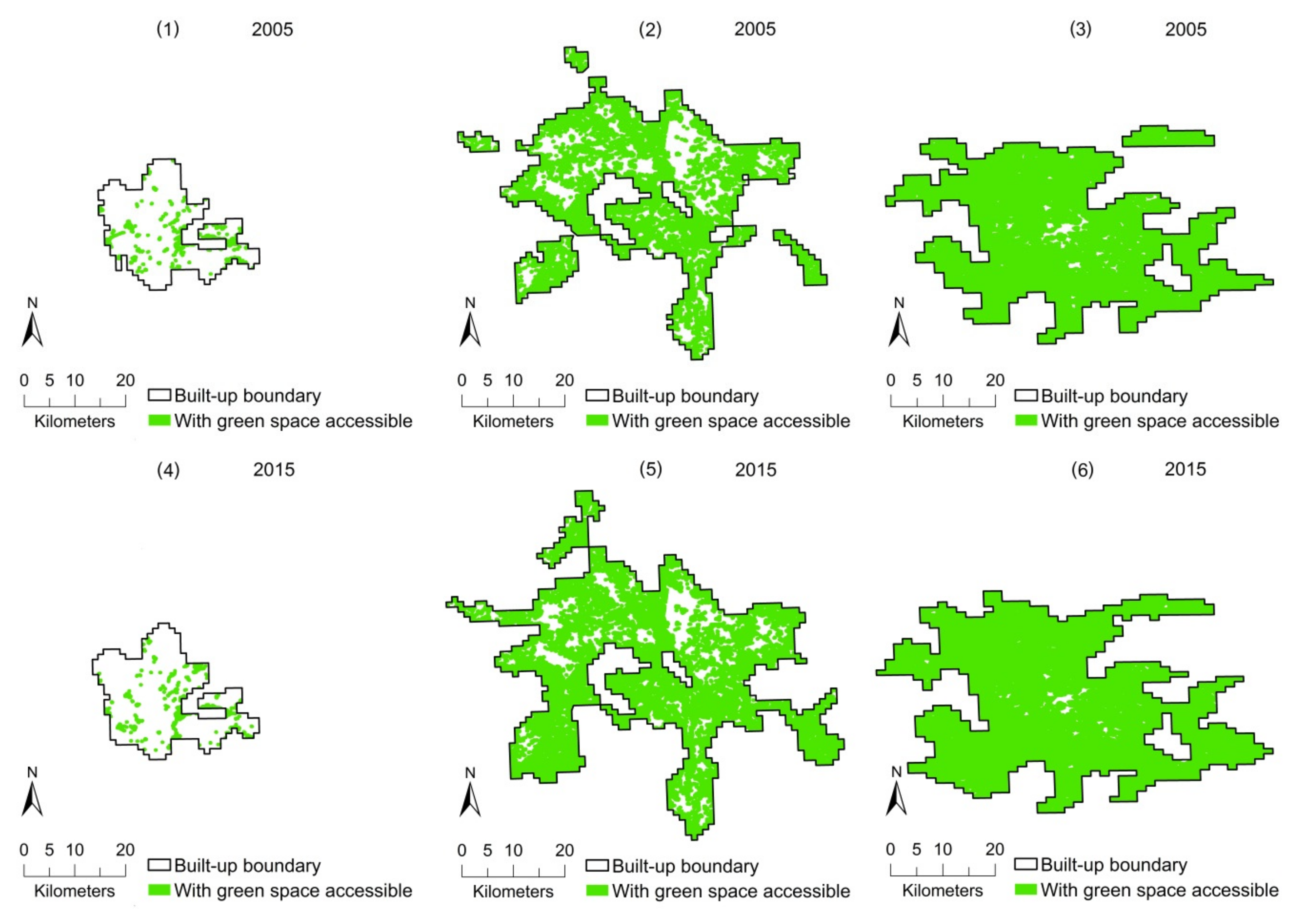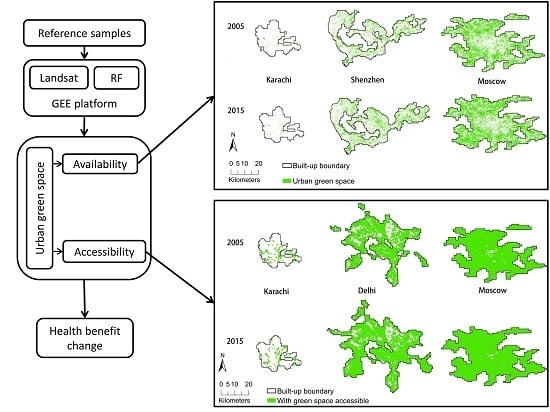Green Spaces as an Indicator of Urban Health: Evaluating Its Changes in 28 Mega-Cities
Abstract
:1. Introduction
2. Materials and Methods
2.1. Study Area
2.2. Reference Samples Collection
2.3. Landsat Imagery and Feature Extraction on GEE
2.4. Land Cover Classification and Accuracy Assessment
2.5. Urban Green Space Extraction
2.6. Calculating Availability and Accessibility of Urban Green Spaces
2.7. Statistical Analysis
3. Results
3.1. Accuracy Assessment Result
3.2. Availability of Urban Green Space
3.3. Accessibility of Urban Green Space
4. Discussion
4.1. Availability of Urban Green Spaces and Changes of Health Benefit
4.2. Accessibility of Urban Green Spaces and Changes of Health Benefit
4.3. Joint Influences of Availability and Accessibility
4.4. Limitations of the Current Study
5. Conclusions
Supplementary Materials
Acknowledgments
Author Contributions
Conflicts of Interest
References
- World Health Organization (WHO). Urban Green Spaces and Health: A Review of Evidence; World Health Organization: Geneva, Switzerland, 2016. [Google Scholar]
- Hartig, T.; Mitchell, R.; De Vries, S.; Frumkin, H. Nature and health. Annu. Rev. Public Health 2014, 35, 207–228. [Google Scholar] [CrossRef] [PubMed]
- Annerstedt van den Bosch, M.; Mudu, P.; Uscila, V.; Barrdahl, M.; Kulinkina, A.; Staatsen, B.; Swart, W.; Kruize, H.; Zurlyte, I.; Egorov, A.I. Development of an urban green space indicator and the public health rationale. Scand. J. Soc. Med. 2016, 44, 159–167. [Google Scholar] [CrossRef] [PubMed]
- Ulrich, R. View through a window may influence recovery. Science 1984, 224, 224–225. [Google Scholar] [CrossRef]
- Paquet, C.; Orschulok, T.P.; Coffee, N.T.; Howard, N.J.; Hugo, G.; Taylor, A.W.; Adams, R.J.; Daniel, M. Are accessibility and characteristics of public open spaces associated with a better cardiometabolic health? Landsc. Urban Plan. 2013, 118, 70–78. [Google Scholar] [CrossRef]
- Sturm, R.; Cohen, D. Proximity to urban parks and mental health. J. Ment. Health Policy Econ. 2014, 17, 19–24. [Google Scholar] [PubMed]
- Maas, J.; Verheij, R.A.; Groenewegen, P.P.; De Vries, S.; Spreeuwenberg, P. Green space, urbanity, and health: How strong is the relation? J. Epidemiol. Community Health 2006, 60, 587–592. [Google Scholar] [CrossRef] [PubMed]
- Mitchell, R.; Popham, F. Effect of exposure to natural environment on health inequalities: An observational population study. Lancet 2008, 372, 1655–1660. [Google Scholar] [CrossRef]
- Gidlöf-Gunnarsson, A.; Öhrström, E. Noise and well-being in urban residential environments: The potential role of perceived availability to nearby green areas. Landsc. Urban Plan. 2007, 83, 115–126. [Google Scholar] [CrossRef]
- Zhang, W.; Yang, J.; Ma, L.; Huang, C. Factors affecting the use of urban green spaces for physical activities: Views of young urban residents in beijing. Urban For. Urban Green. 2015, 14, 851–857. [Google Scholar] [CrossRef]
- De Vries, S.; van Dillen, S.M.; Groenewegen, P.P.; Spreeuwenberg, P. Streetscape greenery and health: Stress, social cohesion and physical activity as mediators. Soc. Sci. Med. 2013, 94, 26–33. [Google Scholar] [CrossRef] [PubMed]
- Kuo, M. How might contact with nature promote human health? Promising mechanisms and a possible central pathway. Front. Psychol. 2015, 6, 1093. [Google Scholar] [CrossRef] [PubMed]
- Fuller, R.A.; Irvine, K.N.; Devine-Wright, P.; Warren, P.H.; Gaston, K.J. Psychological benefits of greenspace increase with biodiversity. Biol. Lett. 2007, 3, 390–394. [Google Scholar] [CrossRef] [PubMed]
- Villeneuve, P.J.; Jerrett, M.; Su, J.G.; Burnett, R.T.; Chen, H.; Wheeler, A.J.; Goldberg, M.S. A cohort study relating urban green space with mortality in ontario, canada. Environ. Res. 2012, 115, 51–58. [Google Scholar] [CrossRef] [PubMed]
- Sarkar, C.; Webster, C.; Pryor, M.; Tang, D.; Melbourne, S.; Zhang, X.; Jianzheng, L. Exploring associations between urban green, street design and walking: Results from the greater london boroughs. Landsc. Urban Plan. 2015, 143, 112–125. [Google Scholar] [CrossRef]
- Grigsby-Toussaint, D.S.; Chi, S.-H.; Fiese, B.H. Where they live, how they play: Neighborhood greenness and outdoor physical activity among preschoolers. Int. J. Health Geogr. 2011, 10, 66. [Google Scholar] [CrossRef] [PubMed]
- Mytton, O.T.; Townsend, N.; Rutter, H.; Foster, C. Green space and physical activity: An observational study using health survey for england data. Health Place 2012, 18, 1034–1041. [Google Scholar] [CrossRef] [PubMed]
- Alcock, I.; White, M.P.; Wheeler, B.W.; Fleming, L.E.; Depledge, M.H. Longitudinal effects on mental health of moving to greener and less green urban areas. Environ. Sci. Technol. 2014, 48, 1247–1255. [Google Scholar] [CrossRef] [PubMed] [Green Version]
- Beyer, K.M.; Kaltenbach, A.; Szabo, A.; Bogar, S.; Nieto, F.J.; Malecki, K.M. Exposure to neighborhood green space and mental health: Evidence from the survey of the health of wisconsin. Int. J. Environ. Res. Public Health 2014, 11, 3453–3472. [Google Scholar] [CrossRef] [PubMed]
- Sugiyama, T.; Leslie, E.; Giles-Corti, B.; Owen, N. Associations of neighbourhood greenness with physical and mental health: Do walking, social coherence and local social interaction explain the relationships? J. Epidemiol. Community Health 2008, 62. [Google Scholar] [CrossRef]
- Craig, J.M.; Prescott, S.L. Planning ahead: The mental health value of natural environments. Lancet Planet. Health 2017, 1, e128–e129. [Google Scholar] [CrossRef]
- Tomita, A.; Vandormael, A.M.; Cuadros, D.; Di Minin, E.; Heikinheimo, V.; Tanser, F.; Slotow, R.; Burns, J.K. Green environment and incident depression in south africa: A geospatial analysis and mental health implications in a resource-limited setting. Lancet Planet. Health 2017, 1, e152–e162. [Google Scholar] [CrossRef]
- Mitchell, R.; Popham, F. Greenspace, urbanity and health: Relationships in england. J. Epidemiol. Community Health 2007, 61, 681–683. [Google Scholar] [CrossRef] [PubMed]
- Pereira, G.; Foster, S.; Martin, K.; Christian, H.; Boruff, B.J.; Knuiman, M.; Giles-Corti, B. The association between neighborhood greenness and cardiovascular disease: An observational study. BMC Public Health 2012, 12, 466. [Google Scholar] [CrossRef] [PubMed]
- Van den Bosch, M.A.; Östergren, P.-O.; Grahn, P.; Skärbäck, E.; Währborg, P. Moving to serene nature may prevent poor mental health—Results from a swedish longitudinal cohort study. Int. J. Environ. Res. Public Health 2015, 12, 7974–7989. [Google Scholar] [CrossRef] [PubMed]
- Tamosiunas, A.; Grazuleviciene, R.; Luksiene, D.; Dedele, A.; Reklaitiene, R.; Baceviciene, M.; Vencloviene, J.; Bernotiene, G.; Radisauskas, R.; Malinauskiene, V. Accessibility and use of urban green spaces, and cardiovascular health: Findings from a kaunas cohort study. Environ. Health 2014, 13, 20. [Google Scholar] [CrossRef] [PubMed]
- Hu, Z.; Liebens, J.; Rao, K.R. Linking stroke mortality with air pollution, income, and greenness in northwest florida: An ecological geographical study. Int. J. Health Geogr. 2008, 7, 20. [Google Scholar] [CrossRef] [PubMed]
- Ekkel, E.D.; de Vries, S. Nearby green space and human health: Evaluating accessibility metrics. Landsc. Urban Plan. 2017, 157, 214–220. [Google Scholar] [CrossRef]
- Honold, J.; Lakes, T.; Beyer, R.; van der Meer, E. Restoration in urban spaces: Nature views from home, greenways, and public parks. Environ. Behav. 2016, 48, 796–825. [Google Scholar] [CrossRef]
- Yang, J.; Huang, C.; Zhang, Z.; Wang, L. The temporal trend of urban green coverage in major chinese cities between 1990 and 2010. Urban For. Urban Green. 2014, 13, 19–27. [Google Scholar] [CrossRef]
- Richards, D.R.; Passy, P.; Oh, R.R. Impacts of population density and wealth on the quantity and structure of urban green space in tropical southeast asia. Landsc. Urban Plan. 2017, 157, 553–560. [Google Scholar] [CrossRef]
- Liu, Z.; Mao, F.; Zhou, W.; Li, Q.; Huang, J.; Zhu, X. Accessibility assessment of urban green space: A quantitative perspective. In Proceedings of the IEEE International Geoscience and Remote Sensing Symposium (IGARSS 2008), Boston, MA, USA, 6–11 July 2008; pp. 1314–1317. [Google Scholar]
- Chen, Z.; Xu, B.; Devereux, B. Urban landscape pattern analysis based on 3d landscape models. Appl. Geogr. 2014, 55, 82–91. [Google Scholar] [CrossRef]
- Chen, Z.; Xu, B. Enhancing urban landscape configurations by integrating 3d landscape pattern analysis with people’s landscape preferences. Environ. Earth Sci. 2016, 75, 1018. [Google Scholar] [CrossRef]
- Casalegno, S.; Anderson, K.; Cox, D.T.; Hancock, S.; Gaston, K.J. Ecological connectivity in the three-dimensional urban green volume using waveform airborne lidar. Sci. Rep. 2017, 7, 45571. [Google Scholar] [CrossRef] [PubMed]
- Pu, R.; Landry, S. A comparative analysis of high spatial resolution ikonos and worldview-2 imagery for mapping urban tree species. Remote Sens. Environ. 2012, 124, 516–533. [Google Scholar] [CrossRef]
- Fuller, R.A.; Gaston, K.J. The scaling of green space coverage in european cities. Biol. Lett. 2009, 5, 352–355. [Google Scholar] [CrossRef] [PubMed]
- United Nations. World Urbanization Prospects: The 2014 Revision; Department of Economic and Social Affairs, Population Division, United Nations: New York, NY, USA, 2014. [Google Scholar]
- Gorelick, N.; Hancher, M.; Dixon, M.; Ilyushchenko, S.; Thau, D.; Moore, R. Google earth engine: Planetary-scale geospatial analysis for everyone. Remote Sens. Environ. 2017. [Google Scholar] [CrossRef]
- Huang, H.; Chen, Y.; Clinton, N.; Wang, J.; Wang, X.; Liu, C.; Gong, P.; Yang, J.; Bai, Y.; Zheng, Y. Mapping major land cover dynamics in beijing using all landsat images in google earth engine. Remote Sens. Environ. 2017. [Google Scholar] [CrossRef]
- Tucker, C.J. Red and photographic infrared linear combinations for monitoring vegetation. Remote Sens. Environ. 1979, 8, 127–150. [Google Scholar] [CrossRef]
- Xu, H. Modification of normalised difference water index (ndwi) to enhance open water features in remotely sensed imagery. Int. J. Remote Sens. 2006, 27, 3025–3033. [Google Scholar] [CrossRef]
- Zha, Y.; Gao, J.; Ni, S. Use of normalized difference built-up index in automatically mapping urban areas from tm imagery. Int. J. Remote Sens. 2003, 24, 583–594. [Google Scholar] [CrossRef]
- Hansen, M.C.; Potapov, P.V.; Moore, R.; Hancher, M.; Turubanova, S.; Tyukavina, A.; Thau, D.; Stehman, S.; Goetz, S.; Loveland, T. High-resolution global maps of 21st-century forest cover change. Science 2013, 342, 850–853. [Google Scholar] [CrossRef] [PubMed]
- Sharma, R.C.; Tateishi, R.; Hara, K.; Iizuka, K. Production of the japan 30-m land cover map of 2013–2015 using a random forests-based feature optimization approach. Remote Sens. 2016, 8, 429. [Google Scholar] [CrossRef]
- Azzari, G.; Lobell, D. Landsat-based classification in the cloud: An opportunity for a paradigm shift in land cover monitoring. Remote Sens. Environ. 2017. [Google Scholar] [CrossRef]
- Song, X.-P.; Potapov, P.V.; Krylov, A.; King, L.; Di Bella, C.M.; Hudson, A.; Khan, A.; Adusei, B.; Stehman, S.V.; Hansen, M.C. National-scale soybean mapping and area estimation in the united states using medium resolution satellite imagery and field survey. Remote Sens. Environ. 2017, 190, 383–395. [Google Scholar] [CrossRef]
- Breiman, L. Random forests. Mach. Learn. 2001, 45, 5–32. [Google Scholar] [CrossRef]
- Johansen, K.; Phinn, S.; Taylor, M. Mapping woody vegetation clearing in queensland, australia from landsat imagery using the google earth engine. Remote Sens. Appl. Soc. Environ. 2015, 1, 36–49. [Google Scholar] [CrossRef]
- Li, X.; Gong, P.; Liang, L. A 30-year (1984–2013) record of annual urban dynamics of beijing city derived from landsat data. Remote Sens. Environ. 2015, 166, 78–90. [Google Scholar] [CrossRef]
- Wang, J.; Li, C.; Hu, L.; Zhao, Y.; Huang, H.; Gong, P. Seasonal land cover dynamics in beijing derived from landsat 8 data using a spatio-temporal contextual approach. Remote Sens. 2015, 7, 865–881. [Google Scholar] [CrossRef]
- Zhou, D.; Zhao, S.; Liu, S.; Zhang, L.; Zhu, C. Surface urban heat island in china’s 32 major cities: Spatial patterns and drivers. Remote Sens. Environ. 2014, 152, 51–61. [Google Scholar] [CrossRef]
- Zhou, D.; Zhao, S.; Zhang, L.; Liu, S. Remotely sensed assessment of urbanization effects on vegetation phenology in china’s 32 major cities. Remote Sens. Environ. 2016, 176, 272–281. [Google Scholar] [CrossRef]
- Zhou, Y.; Smith, S.J.; Zhao, K.; Imhoff, M.; Thomson, A.; Bond-Lamberty, B.; Asrar, G.R.; Zhang, X.; He, C.; Elvidge, C.D. A global map of urban extent from nightlights. Environ. Res. Lett. 2015, 10. [Google Scholar] [CrossRef]
- European Commission, Joint Research Centre (JRC); Columbia University, Center for International Earth Science Information Network. GHS Population Grid, Derived from GPW4, Multitemporal (1975, 1990, 2000, 2015). Available online: http://data.Europa.Eu/89h/jrc-ghsl-ghs_pop_gpw4_globe_r2015a (accessed on 28 June 2017).
- Hijmans, R.J.; Cameron, S.E.; Parra, J.L.; Jones, P.G.; Jarvis, A. Very high resolution interpolated climate surfaces for global land areas. Int. J. Climatol. 2005, 25, 1965–1978. [Google Scholar] [CrossRef]
- Dobbs, R.; Smit, S.; Remes, J.; Manyika, J.; Roxburgh, C.; Restrepo, A. Urban World: Mapping the Economic Power of Cities; McKinsey Global Institute: Seoul, Korea, 2011. [Google Scholar]
- Thomlinson, J.R.; Bolstad, P.V.; Cohen, W.B. Coordinating methodologies for scaling landcover classifications from site-specific to global: Steps toward validating global map products. Remote Sens. Environ. 1999, 70, 16–28. [Google Scholar] [CrossRef]
- Dobbs, C.; Nitschke, C.; Kendal, D. Assessing the drivers shaping global patterns of urban vegetation landscape structure. Sci. Total Environ. 2017, 592, 171–177. [Google Scholar] [CrossRef] [PubMed]
- Kabisch, N.; Haase, D. Green spaces of european cities revisited for 1990–2006. Landsc. Urban Plan. 2013, 110, 113–122. [Google Scholar] [CrossRef]
- Nowak, D.J.; Greenfield, E.J. Tree and impervious cover change in us cities. Urban For. Urban Green. 2012, 11, 21–30. [Google Scholar] [CrossRef]
- Qureshi, S. The fast growing megacity karachi as a frontier of environmental challenges: Urbanization and contemporary urbanism issues. J. Geogr. Reg. Plan. 2010, 3, 306–321. [Google Scholar]
- Khwaja, H.A.; Fatmi, Z.; Malashock, D.; Aminov, Z.; Kazi, A.; Siddique, A.; Qureshi, J.; Carpenter, D.O. Effect of air pollution on daily morbidity in karachi, pakistan. J. Local Glob. Health Sci. 2013, 3, 1–13. [Google Scholar] [CrossRef]
- Sajjad, S.H.; Blond, N.; Batool, R.; Shirazi, S.A.; Shakrullah, K.; Bhalli, M.N. Study of urban heat island of karachi by using finite volume mesoscale model. J. Basic Appl. Sci. 2015, 11, 101–105. [Google Scholar] [CrossRef]
- Wolch, J.R.; Byrne, J.; Newell, J.P. Urban green space, public health, and environmental justice: The challenge of making cities ‘just green enough’. Landsc. Urban Plan. 2014, 125, 234–244. [Google Scholar] [CrossRef]
- Peschardt, K.K.; Schipperijn, J.; Stigsdotter, U.K. Use of small public urban green spaces (spugs). Urban For. Urban Green. 2012, 11, 235–244. [Google Scholar] [CrossRef]
- Yu, Z.; Wang, Y.; Deng, J.; Shen, Z.; Wang, K.; Zhu, J.; Gan, M. Dynamics of hierarchical urban green space patches and implications for management policy. Sensors 2017, 17, 1304. [Google Scholar] [CrossRef] [PubMed]
- Qureshi, S.; Kazmi, S.J.H.; Breuste, J.H. Ecological disturbances due to high cutback in the green infrastructure of karachi: Analyses of public perception about associated health problems. Urban For. Urban Green. 2010, 9, 187–198. [Google Scholar] [CrossRef]
- Connors, J.P.; Galletti, C.S.; Chow, W.T. Landscape configuration and urban heat island effects: Assessing the relationship between landscape characteristics and land surface temperature in phoenix, arizona. Landsc. Ecol. 2013, 28, 271–283. [Google Scholar] [CrossRef]
- De Clercq, E.M.; De Wulf, R.; Van Herzele, A. Relating spatial pattern of forest cover to accessibility. Landsc. Urban Plan. 2007, 80, 14–22. [Google Scholar] [CrossRef]
- Zhang, Y.; Murray, A.T.; Turner, B. Optimizing green space locations to reduce daytime and nighttime urban heat island effects in phoenix, arizona. Landsc. Urban Plan. 2017, 165, 162–171. [Google Scholar] [CrossRef]
- Haaland, C.; van den Bosch, C.K. Challenges and strategies for urban green-space planning in cities undergoing densification: A review. Urban For. Urban Green. 2015, 14, 760–771. [Google Scholar] [CrossRef]
- United Nations. Sustainable Development Goals. Available online: Http://www.Un.Org/sustainabledevelopment/sustainable-development-goals/ (accessed on 28 June 2017).
- Van den Berg, A.E.; Maas, J.; Verheij, R.A.; Groenewegen, P.P. Green space as a buffer between stressful life events and health. Soc. Sci. Med. 2010, 70, 1203–1210. [Google Scholar] [CrossRef] [PubMed]



| Class Type | 2005 | 2015 | ||
|---|---|---|---|---|
| Number of Polygons or Sites | Number of Pixels | Number of Polygons or Sites | Number of Pixels | |
| Bare soil | 2008 | 9840 | 2616 | 15,643 |
| Crop | 2581 | 9717 | 3364 | 15,408 |
| Grass | 2886 | 14,615 | 3761 | 21,213 |
| Impervious surfaces | 4818 | 72,404 | 6279 | 85,196 |
| Tree/shrub | 4610 | 37,474 | 6007 | 48,482 |
| Water | 2294 | 12,428 | 2990 | 19,667 |
| Sum | 19,197 | 156,478 | 25,018 | 205,609 |
| Megacity | PUGS (%) | AI (%) | ||||
|---|---|---|---|---|---|---|
| 2005 | 2015 | Δ05–15 | 2005 | 2015 | Δ05–15 | |
| Los Angeles-Long Beach-Santa Ana | 20.29 | 18.20 | −2.09 | 56.12 | 52.75 | −3.37 |
| Mexico City | 21.70 | 28.00 | 6.30 | 52.21 | 57.81 | 5.60 |
| New York-Newark | 41.72 | 44.56 | 2.84 | 73.36 | 78.34 | 4.98 |
| Rio de Janeiro | 37.86 | 38.43 | 0.57 | 78.59 | 80.08 | 1.48 |
| São Paulo | 27.40 | 30.15 | 2.75 | 67.92 | 71.46 | 3.54 |
| Buenos Aires | 32.99 | 34.10 | 1.11 | 71.83 | 72.99 | 1.16 |
| London | 46.38 | 58.42 | 12.04 | 95.66 | 98.53 | 2.88 |
| Paris | 42.30 | 52.50 | 10.20 | 83.70 | 91.66 | 7.96 |
| Moscow | 52.79 | 56.61 | 3.82 | 98.51 | 99.25 | 0.75 |
| Istanbul | 23.70 | 28.95 | 5.25 | 59.60 | 68.07 | 8.46 |
| Cairo | 12.15 | 11.83 | −0.32 | 32.28 | 27.79 | −4.49 |
| Lagos | 20.17 | 18.55 | −1.62 | 61.54 | 57.76 | −3.78 |
| Kinshasa | 9.32 | 23.53 | 14.21 | 26.78 | 55.60 | 28.82 |
| Karachi | 3.24 | 2.73 | −0.51 | 11.57 | 10.84 | −0.72 |
| Delhi | 26.01 | 32.47 | 6.46 | 69.41 | 75.19 | 5.78 |
| Mumbai | 26.01 | 27.63 | 1.62 | 77.15 | 80.23 | 3.08 |
| Kolkata | 29.34 | 35.21 | 5.87 | 77.78 | 89.06 | 11.28 |
| Dhaka | 17.10 | 20.9 | 3.80 | 62.48 | 68.86 | 6.37 |
| Beijing | 33.88 | 41.82 | 7.94 | 77.91 | 91.97 | 14.06 |
| Tianjin | 21.35 | 23.44 | 2.09 | 60.09 | 74.02 | 13.93 |
| Chongqing | 35.97 | 47.58 | 11.61 | 78.22 | 98.32 | 20.09 |
| Shanghai | 31.11 | 32.01 | 0.90 | 63.19 | 85.50 | 22.30 |
| Guangzhou | 28.70 | 36.08 | 7.38 | 59.11 | 76.42 | 17.31 |
| Shenzhen | 24.74 | 30.05 | 5.31 | 70.44 | 83.93 | 13.50 |
| Manila | 24.69 | 31.82 | 7.13 | 67.40 | 74.84 | 7.44 |
| Jakarta | 34.87 | 36.03 | 1.16 | 85.60 | 86.92 | 1.33 |
| Osaka | 22.50 | 21.37 | −1.13 | 56.67 | 59.14 | 2.46 |
| Tokyo | 25.32 | 25.85 | 0.53 | 66.08 | 72.77 | 6.69 |
| Average | 27.63 | 31.74 | 4.11 | 65.76 | 72.86 | 7.10 |
| Factor | 2005 | 2015 | ||||||
|---|---|---|---|---|---|---|---|---|
| Coefficient | SE | t | p | Coefficient | SE | t | p | |
| Intercept | 27.629 | 1.609 | 17.175 | <0.001 | 31.744 | 1.964 | 16.165 | <0.001 |
| Annual mean temperature | −7.164 | 3.017 | −2.374 | 0.026 | −9.715 | 3.683 | −2.638 | 0.015 |
| Annual precipitation | 4.733 | 2.032 | 2.329 | 0.029 | 6.142 | 2.481 | 2.476 | 0.021 |
| Population density | −0.597 | 2.292 | −0.261 | 0.797 | 0.009 | 2.798 | 0.003 | 0.998 |
| Per capita GDP | 1.642 | 2.687 | 0.611 | 0.547 | 0.375 | 3.28 | 0.114 | 0.91 |
| Factor | 2005 | 2015 | ||||||
|---|---|---|---|---|---|---|---|---|
| Coefficient | SE | t | p | Coefficient | SE | t | p | |
| Intercept | 66.349 | 3.042 | 21.812 | <0.001 | 73.263 | 3.061 | 23.937 | <0.001 |
| Annual mean temperature | −11.998 | 5.705 | −2.103 | 0.047 | −16.215 | 5.74 | −2.825 | 0.01 |
| Annual precipitation | 11.197 | 3.843 | 2.914 | 0.008 | 13.561 | 3.867 | 3.507 | 0.002 |
| Population density | 0.39 | 4.334 | 0.09 | 0.929 | −1.859 | 4.361 | −0.426 | 0.674 |
| Per capita GDP | 1.703 | 5.08 | 0.335 | 0.74 | −3.888 | 5.112 | −0.761 | 0.455 |
© 2017 by the authors. Licensee MDPI, Basel, Switzerland. This article is an open access article distributed under the terms and conditions of the Creative Commons Attribution (CC BY) license (http://creativecommons.org/licenses/by/4.0/).
Share and Cite
Huang, C.; Yang, J.; Lu, H.; Huang, H.; Yu, L. Green Spaces as an Indicator of Urban Health: Evaluating Its Changes in 28 Mega-Cities. Remote Sens. 2017, 9, 1266. https://doi.org/10.3390/rs9121266
Huang C, Yang J, Lu H, Huang H, Yu L. Green Spaces as an Indicator of Urban Health: Evaluating Its Changes in 28 Mega-Cities. Remote Sensing. 2017; 9(12):1266. https://doi.org/10.3390/rs9121266
Chicago/Turabian StyleHuang, Conghong, Jun Yang, Hui Lu, Huabing Huang, and Le Yu. 2017. "Green Spaces as an Indicator of Urban Health: Evaluating Its Changes in 28 Mega-Cities" Remote Sensing 9, no. 12: 1266. https://doi.org/10.3390/rs9121266






